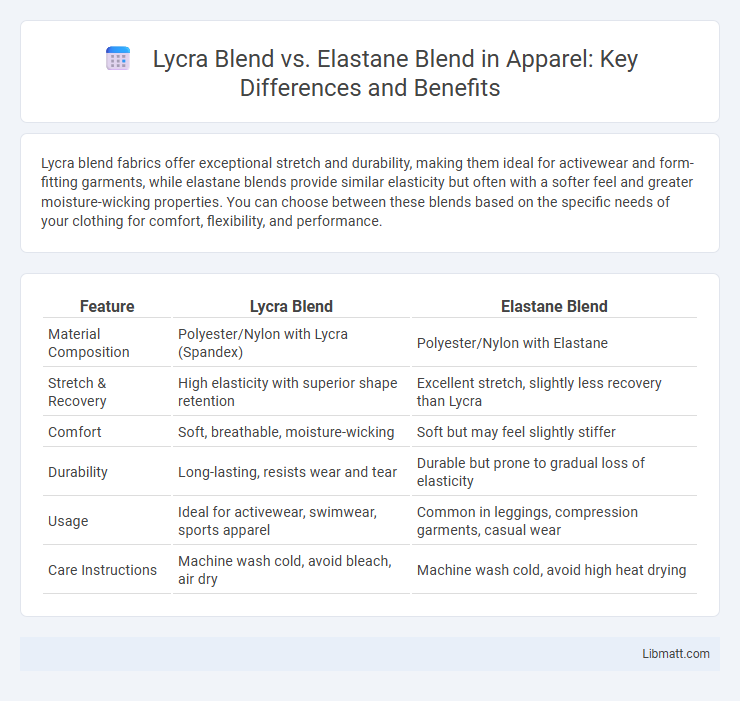Lycra blend fabrics offer exceptional stretch and durability, making them ideal for activewear and form-fitting garments, while elastane blends provide similar elasticity but often with a softer feel and greater moisture-wicking properties. You can choose between these blends based on the specific needs of your clothing for comfort, flexibility, and performance.
Table of Comparison
| Feature | Lycra Blend | Elastane Blend |
|---|---|---|
| Material Composition | Polyester/Nylon with Lycra (Spandex) | Polyester/Nylon with Elastane |
| Stretch & Recovery | High elasticity with superior shape retention | Excellent stretch, slightly less recovery than Lycra |
| Comfort | Soft, breathable, moisture-wicking | Soft but may feel slightly stiffer |
| Durability | Long-lasting, resists wear and tear | Durable but prone to gradual loss of elasticity |
| Usage | Ideal for activewear, swimwear, sports apparel | Common in leggings, compression garments, casual wear |
| Care Instructions | Machine wash cold, avoid bleach, air dry | Machine wash cold, avoid high heat drying |
Understanding Lycra Blend and Elastane Blend
Lycra Blend and Elastane Blend both refer to fabrics that incorporate stretch fibers, enhancing comfort and flexibility in clothing. Lycra is a branded type of elastane known for its superior elasticity and durability, commonly used in activewear and fitted garments. Understanding these blends helps you choose fabrics that offer optimal stretch, shape retention, and performance for your specific wardrobe needs.
Composition and Material Differences
Lycra blend fabrics primarily consist of a combination of Lycra (a brand of spandex) and natural or synthetic fibers like cotton or polyester, offering superior elasticity and comfort. Elastane blend fabrics contain elastane fibers mixed with other materials, providing similar stretch properties but often with slight differences in durability and texture depending on the base fibers used. The key material distinction lies in brand specificity--Lycra is a patented type of elastane known for consistent quality, while elastane refers broadly to the fiber family used in various textile blends.
Stretch and Recovery Comparison
Lycra Blend fabrics provide superior stretch and recovery due to the high-quality spandex fibers that maintain shape and elasticity even after repeated wear. Elastane Blend materials offer excellent stretch but may have slightly less recovery power compared to Lycra, making Lycra the preferred choice for garments requiring consistent support and flexibility. Your choice between Lycra Blend and Elastane Blend should consider how much stretch retention and durability you need for active or fitted clothing.
Comfort and Wearability
Lycra blend fabrics are renowned for their exceptional stretch and recovery, providing superior comfort and maintaining shape during extended wear. Elastane blends offer similar elasticity but often emphasize durability and resistance to wear, ensuring garments remain comfortable over time without losing flexibility. Choosing a Lycra blend can enhance your comfort with a soft, smooth feel, while elastane blends excel in wearability for active, long-lasting use.
Durability and Longevity
Lycra blend fabrics offer superior durability due to their high resistance to wear and tear, maintaining shape and elasticity over prolonged use. Elastane blends also provide excellent stretch and recovery but may degrade faster under frequent washing or intense physical activity. For your activewear or daily clothing, choosing a Lycra blend ensures longer-lasting performance and sustained fabric resilience.
Breathability and Moisture Control
Lycra blend fabrics offer excellent breathability and moisture-wicking properties due to their synthetic fiber composition combined with breathable materials like cotton or polyester. Elastane blend fabrics, while highly stretchable, tend to have lower breathability but still provide adequate moisture control when blended with moisture-wicking fibers. Choosing between Lycra and elastane blends depends on the specific fabric combination aimed at enhancing ventilation and efficient moisture management in activewear.
Usage in Fashion and Sportswear
Lycra blend fabrics are highly favored in fashion for their exceptional stretch and shape retention, making them ideal for form-fitting garments such as dresses and activewear. Elastane blends dominate sportswear due to their superior elasticity and moisture-wicking properties, enhancing comfort and performance during intense physical activities. Both materials contribute to improved mobility and durability in apparel but differ in specific fiber composition and fabric feel, aligning with distinct functional applications.
Care and Maintenance Tips
Lycra blend fabrics require gentle washing with cold water and mild detergent to preserve their elasticity and prevent damage. Elastane blend garments should be stored away from direct sunlight and heat sources to maintain fiber integrity and extend lifespan. Following these care guidelines ensures your clothing retains stretchability, shape, and vibrant color for longer use.
Environmental Impact of Each Blend
Lycra blend fabrics often contain a higher percentage of synthetic fibers derived from petroleum, contributing to greater environmental pollution and longer decomposition periods compared to elastane blends. Elastane blends tend to use fewer chemical additives and may incorporate biodegradable components, slightly reducing their overall carbon footprint. When choosing your fabric, consider the environmental impact of production processes and end-of-life recyclability to make a more sustainable decision.
How to Choose: Lycra Blend vs Elastane Blend
When choosing between Lycra blend and elastane blend fabrics, consider the specific elasticity and durability required for your garment; Lycra, a brand name for a type of elastane, typically offers superior stretch recovery and shape retention. Evaluate the intended use, such as activewear or everyday clothing, where Lycra blends provide enhanced comfort and performance, while generic elastane blends may offer cost-effective flexibility. Assess the fabric composition percentages and blend qualities, as higher Lycra content often correlates with better resilience and moisture-wicking properties.
Lycra Blend vs Elastane Blend Infographic

 libmatt.com
libmatt.com